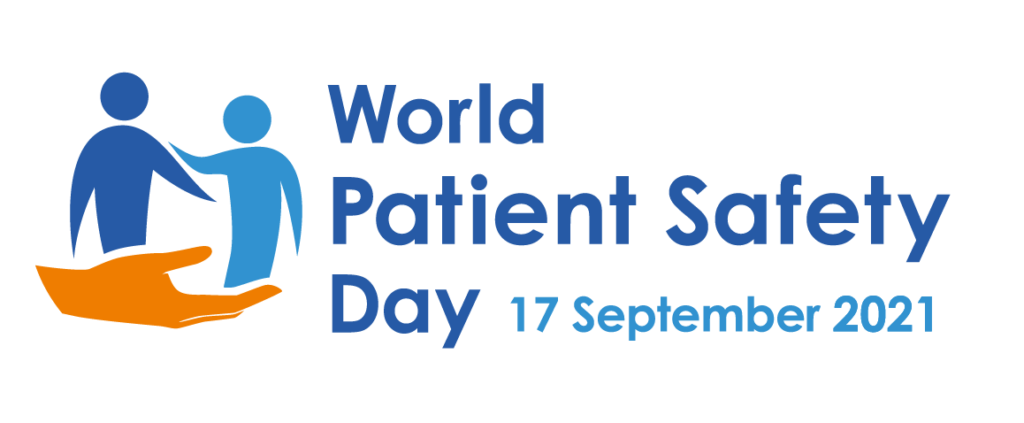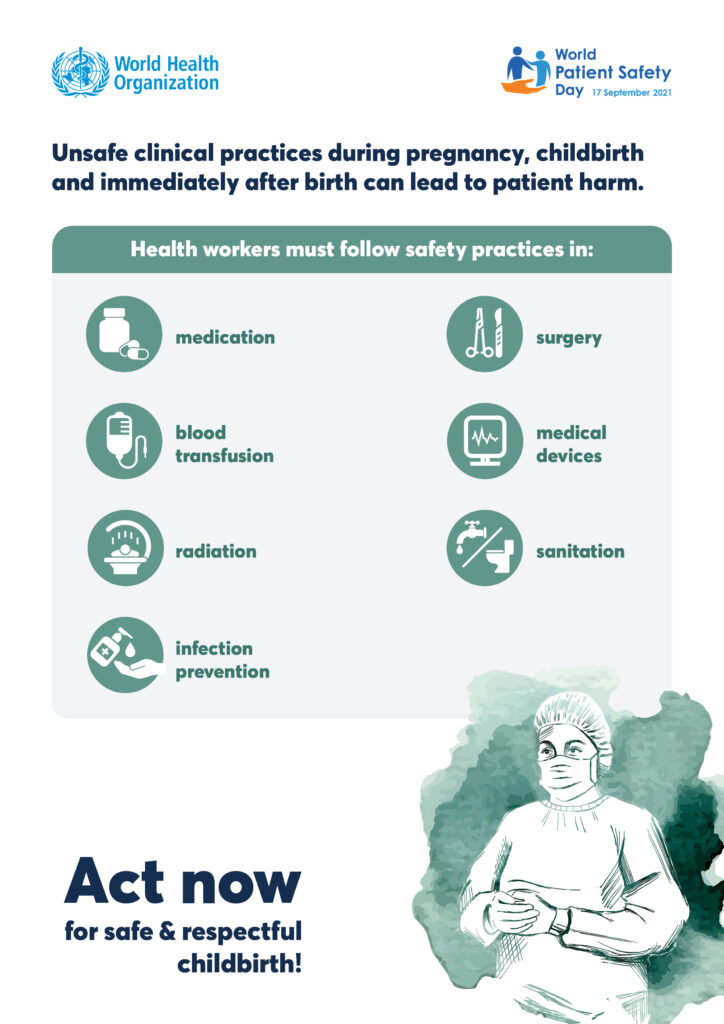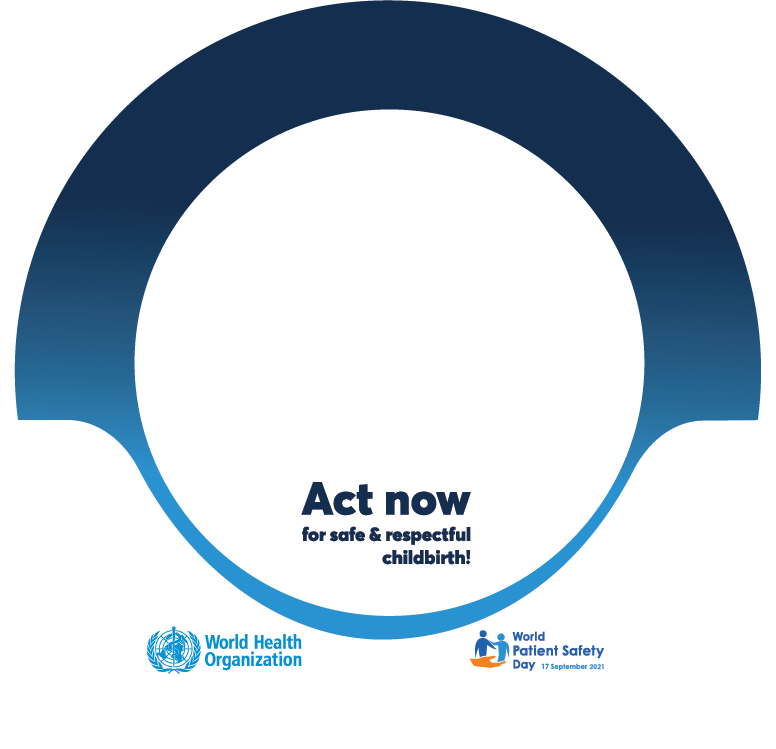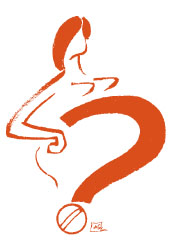
For World Patient Safety Day, 17 September 2021, WHO urges all stakeholders to “Act now for safe and respectful childbirth!” with the theme “Safe maternal and newborn care”.

Considering the significant burden of harm women and newborns are exposed to due to unsafe care, this year’s World Patient Safety Day is dedicated to the need to prioritize and address safety in maternal and newborn care, particularly around the time of childbirth, when most harm occurs. This is especially important in the context of disruption of health services due to the COVID-19 pandemic, which has further compounded the situation.
Among safety measures during pregnancy, childbirth and the immediate postnatal period, medication safety is a key component.
Medication during childbirth and the immediate postnatal period
A medication error can threaten a mother during childbirth, especially in the case of epidurals, infusions or invasive procedures. These risks are mainly related to the operating conditions, preparation and administration of injectable drugs. Some of these medication safety issues are well known to cause harmful and fatal errors in mothers and neonatal patients despite knowledge of repeated occurrence and warnings.
The risk of medication errors is increased in pediatrics and neonatology for many reasons: lack of pediatric formulations, dosage forms and guidelines; confusion between adult and pediatric formulations; confusion among concentrations of oral liquids; look-alike packaging and confusion with drug names; multiple dosing styles; calculation errors; measuring devices; nonstandard concentrations and dilutions; preparation of IV admixtures; IV administration of enteral fluids, etc.
Mother and newborn are more often together on the same delivery unit, same room, having stored their medications together in the same storage area. That has led to mix-ups, such as giving mother hepatitis B vaccine instead of the birth dose intended for the newborn, a common error, and methylergometrine to the newborn instead of the mother. Another problem is identification of mother and newborn since the baby may not yet have a name and may be given same last name as the mother.
"A medication error in a child is often compounded by the need for additional calculations to determine the dose. Many medicines prescribed for children are only available as adult dose forms. Sometimes complex manipulations are necessary to prepare doses for very small babies. Ideally, small doses for intravenous administration should be prepared centrally in the pharmacy. Staff prescribing or giving drugs in paediatrics and neonatology should demonstrate competence in calculation skills."
in “Building a Safer NHS for Patients: Improving Medication Safety” UK NHS; January 22, 2004, p.77.
 Many of the resources provided by the International Medication Safety Network (IMSN) are applicable to medication safety during childbirth and the postpartum period for both mothers and newborns.
Many of the resources provided by the International Medication Safety Network (IMSN) are applicable to medication safety during childbirth and the postpartum period for both mothers and newborns.
IMSN Global Targeted Medication Safety Best Practices
The International Medication Safety Network (IMSN) promotes risk-reduction strategies, called the Global Targeted Medication Safety Best Practices, to inspire and mobilize widespread, international adoption of consensus-based best practices for specific medication safety issues that continue to lead to harmful and deadly medication errors. In particular during childbirth and the postpartum period, it is the case for concentrated injectable electrolytes, such as magnesium or potassium; mix-ups between IV and peridural medicine, such as tranexamic acid, local anesthetics; vaccines extemporaneous preparation, etc. Among others, see as example:
- Global Medication Safety Best Practice 1
Remove potassium concentrate injection from drug storage areas on all inpatient nursing units/wards
- Global Medication Safety Best Practice 4
Prevent errors related to improper preparation of 2-component vaccines
IMSN advocacy to improve medication safety at a global level
The International Medication Safety Network issues recommendations to regulators, pharmaceutical industry and healthcare providers in several domains such as medication error reporting and learning, unsafe medicines naming, labeling and packaging, etc. In particular for both mothers and newborns, it is the case of liquid form dosing preparation, inadequate measuring devices, and also various types of vaccination and medication errors including mix-ups between mothers and newborn. Among other, see as example:
- IMSN Position Statement on Safer Design of Vaccines Packaging and Labelling
Read on...
- IMSN Position Paper on Making Medicines Naming, Labelling and Packaging Safer
Read on...
IMSN updated resources on medication errors
IMSN member publications are a unique source of information on medication error risk, occurrence and prevention, with in-depth, specialized and high-level analysis providing unparalleled insight and action. Like an intelligence hub, all the latest information in this field is gathered on a single page and constantly updated. Of course, you can also find the latest information on the risks of errors threatening mothers and newborns.
Enjoy IMSN members publications...
The International Medication Error Reporting Portal

The International Medication Safety Network provides an international medication error reporting portal for the international healthcare community, to learn from these experiences and be in position to prevent future errors and possible patient harm. Any healthcare provider worldwide, including physicians, pharmacists, nurses, and other healthcare workers including those in the regulatory and the medical products industry can share their report for international review. Reports are investigated by the International Medication Safety Management Fellows at the Institute for Safe Medication Practices (ISMP) in the United States under the supervision of medication safety expert members of the IMSN.
- Here you can report to IMSN
- Here you can see how to learn from your reports, with the great example of the ivm VMI Praktijkprikkels (Practice Stings), whose last issue is about a mix-up between a newborn and her mother in administering hepatitis B vaccine and hepatitis B immunoglobulin
Medication during pregnancy: 10 principles to prevent adverse effects in the unborn child

For a woman who is pregnant, or who might be or become pregnant, taking certain medications can expose the unborn child to harmful effects, often poorly known, and sometimes extremely serious and irreversible. Prescrire, an IMSN member also an independent drug bulletin, promotes several principles useful in preventing them:
- use caution when it comes to any woman who is pregnant, who might be pregnant, or who might soon become pregnant;
- know the patently toxic drugs in order to avoid these drugs, or else to provide for effective contraception;
- be aware that there is great uncertainty and lack of knowledge when it comes to most drugs;
- avoid any treatments whose efficacy is uncertain;
- take both the mother and the child into account when evaluating a treatment’s harm-benefit balance;
- take maximum precautions during the first trimester of pregnancy: it is best to use a tried and tested drug, at minimal doses, and for the shortest time possible;
- late in the pregnancy, be aware of the drug’s known effects outside of pregnancy, and take them into account;
- keep in mind that the long-term effects on the development of the unborn child are unknown;
- inform patients about the dangers of medications taken during pregnancy;
- organise monitoring and management of any adverse effects that can be anticipated in children.
Systematically think about the possibility of pregnancy. Thinking about drug risk is one thing. Thinking about drug risk during pregnancy is another. It is another to think systematically about the eventuality of a pregnancy...
